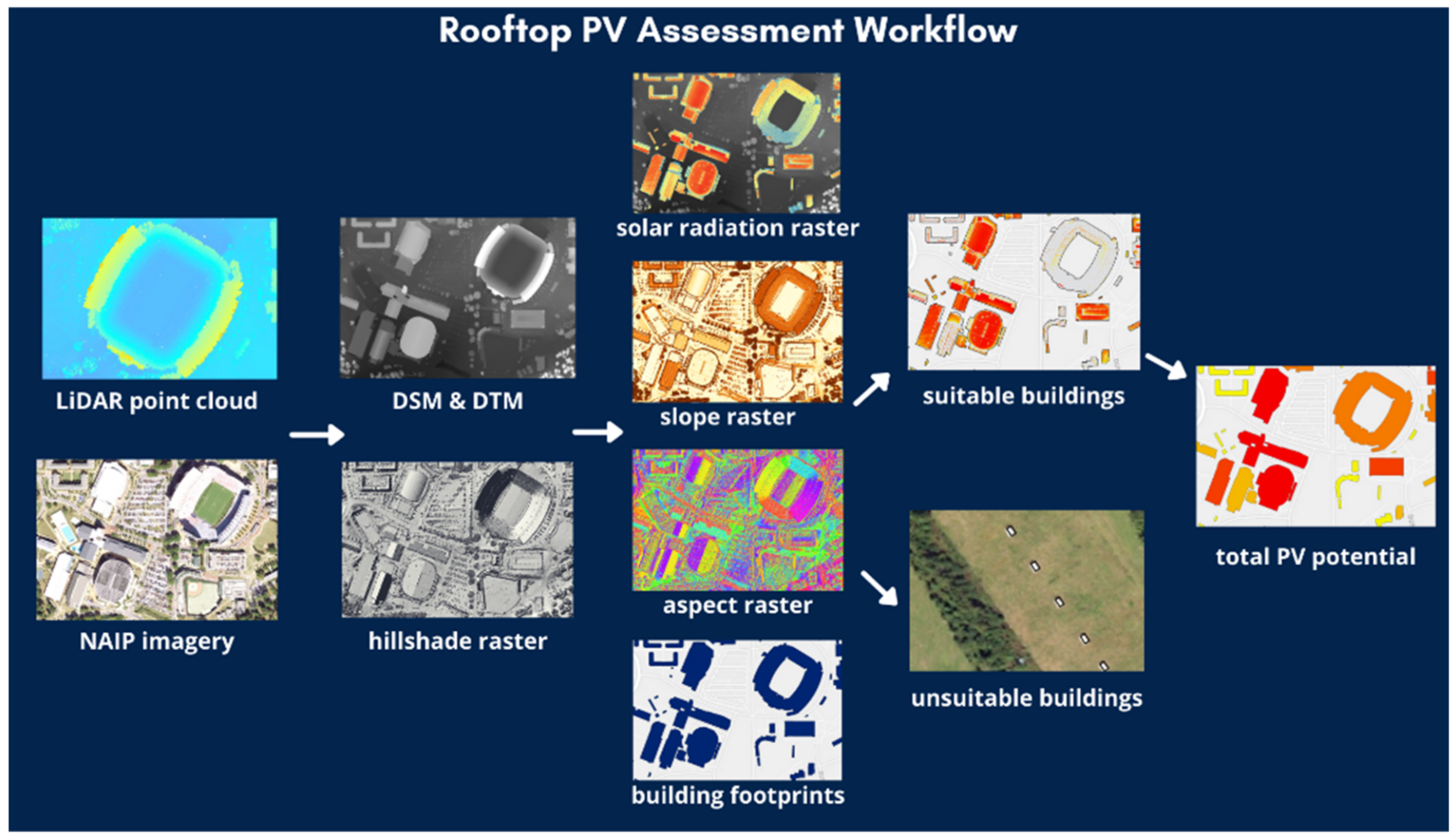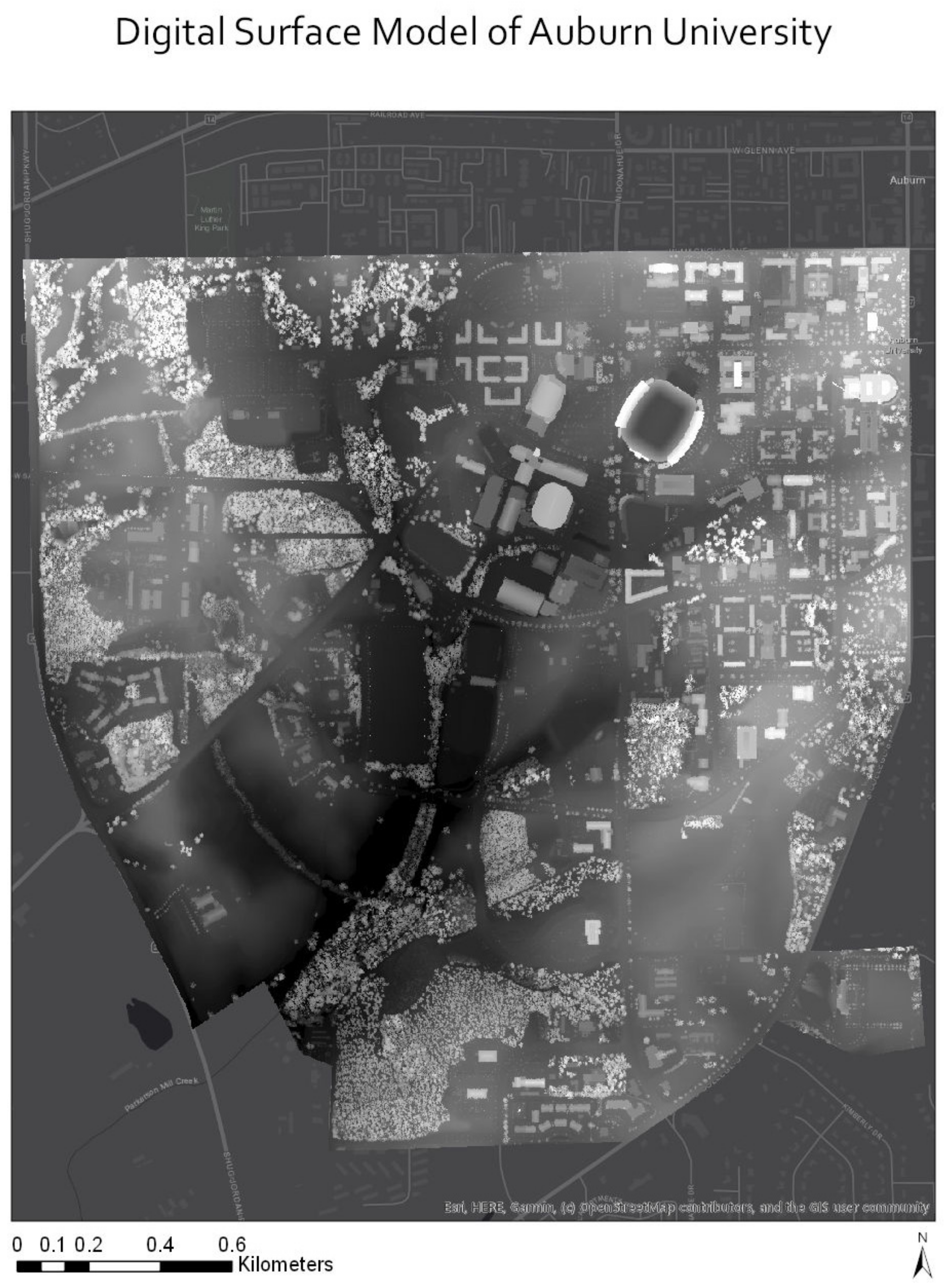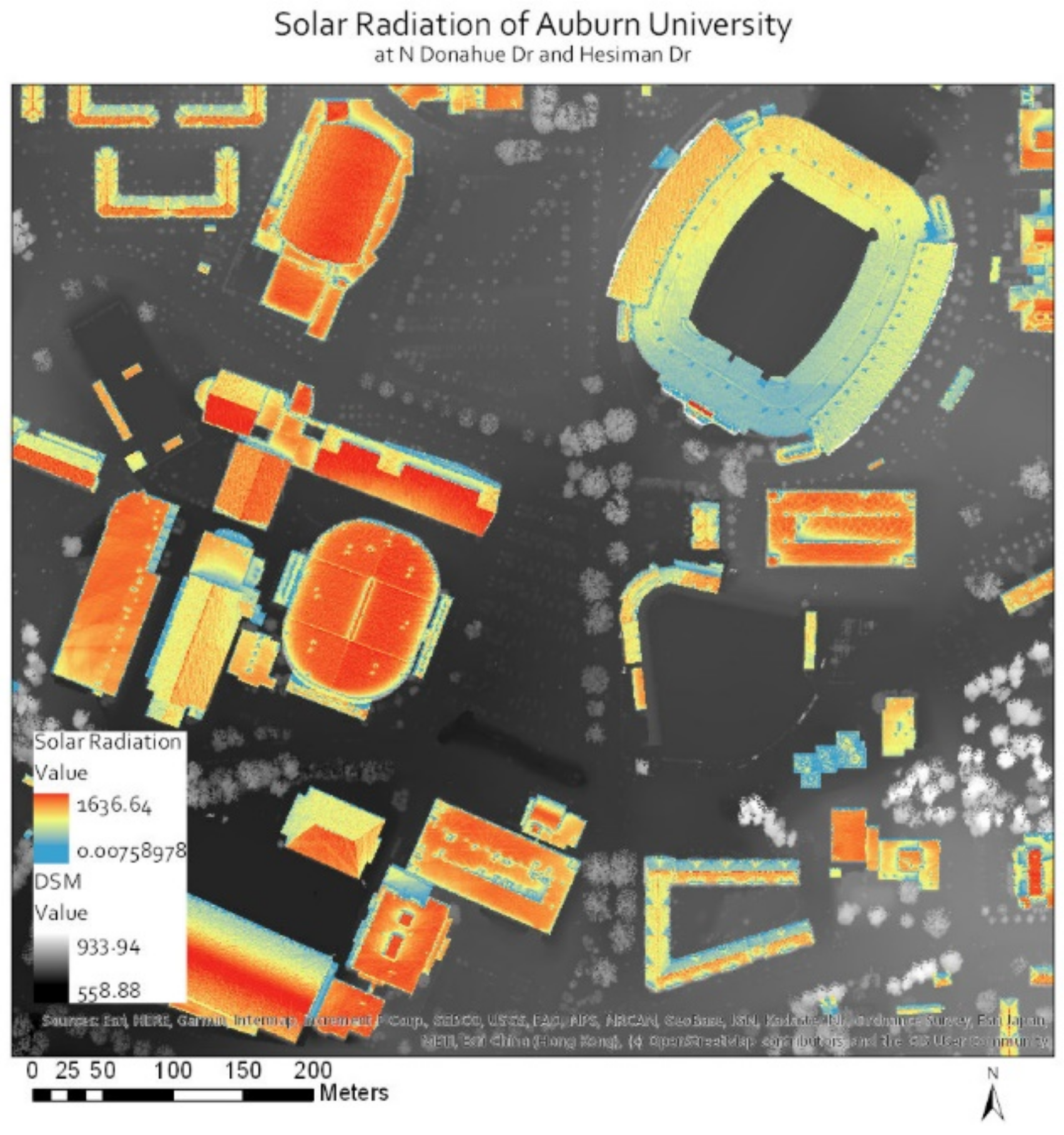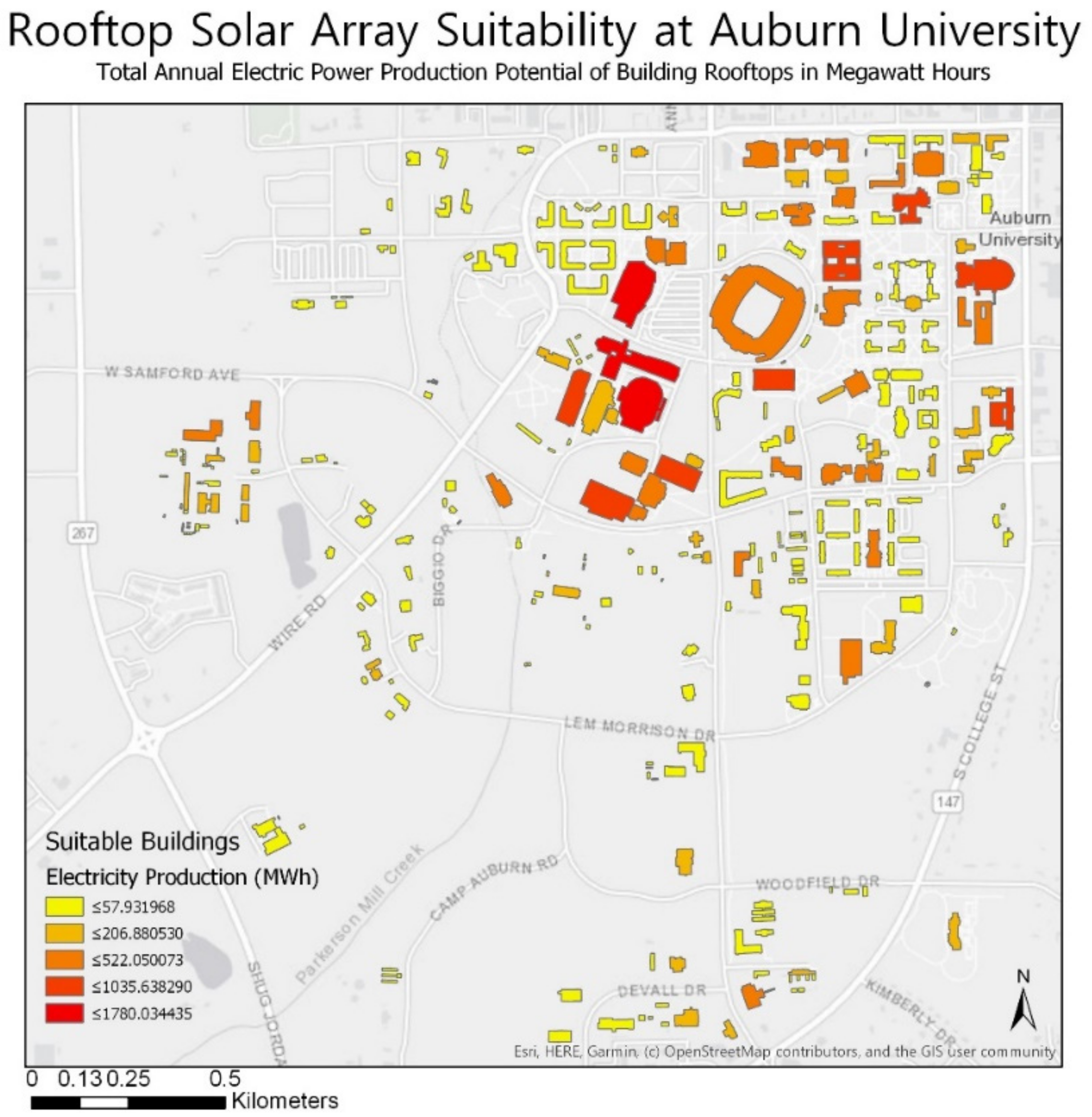Sustainability at Auburn University: Assessing Rooftop Solar Energy Potential for Electricity Generation with Remote Sensing and GIS in a Southern US Campus
Abstract
:1. Introduction
2. Materials and Methods
2.1. Study Area
2.2. Data
2.2.1. Lidar Point Clouds to Raster Products
2.2.2. Building Footprints
2.2.3. Rooftop Suitability
2.2.4. Energy and Electricity Assessment
3. Results
3.1. Rooftop Suitability
3.2. Electricity Summary
3.3. Financial Assessment
4. Discussion
5. Conclusions
Author Contributions
Funding
Institutional Review Board Statement
Informed Consent Statement
Acknowledgments
Conflicts of Interest
References
- February 19; Denchak, 2021 Melissa Paris Climate Agreement: Everything You Need to Know. Available online: https://www.nrdc.org/stories/paris-climate-agreement-everything-you-need-know (accessed on 20 July 2021).
- Alabama Solar. Available online: https://www.seia.org/state-solar-policy/alabama-solar (accessed on 20 July 2021).
- U.S. Solar Market Insight. Available online: https://www.seia.org/us-solar-market-insight (accessed on 29 July 2021).
- Better Buildings Alliance–Higher Education. Available online: https://betterbuildingsinitiative.energy.gov/alliance/sector/higher-education (accessed on 1 December 2021).
- Van Geet, O.; Polly, B.; Pless, S.; Heeter, J. Zero Energy University Campuses: A 2018 Progress Update on Reaching Campus Energy Goals: Preprint; National Renewable Energy Laboratory: Golden, CO, USA, 2018. Available online: https://www.nrel.gov/docs/fy18osti/71822.pdf (accessed on 1 December 2021).
- Kanters, J.; Davidsson, H. Mutual Shading of PV Modules on Flat Roofs: A Parametric Study. Energy Procedia 2014, 57, 1706–1715. [Google Scholar] [CrossRef] [Green Version]
- Gagnon, P.; Margolis, R.; Melius, J.; Phillips, C.; Elmore, R. Rooftop Solar Photovoltaic Technical Potential in the United States: A Detailed Assessment; National Renewable Energy Laboratory: Golden, CO, USA, 2016; p. 70. [Google Scholar]
- Average Annual Sunshine by USA State-Current Results. Available online: https://www.currentresults.com/Weather/US/average-annual-state-sunshine.php (accessed on 29 July 2021).
- Mean Number of Days with Precipitation 0.01 Inches or More. Available online: https://www.weather.gov/ddc/meanprecip (accessed on 30 July 2021).
- Auburn University Climate Action Plan V.1.1. Available online: https://www.ncei.noaa.gov/pub/data/ccd-data/prge0118.dat (accessed on 1 December 2021).
- Auburn University|Quick Facts–Enrollment. Available online: http://www.auburn.edu (accessed on 29 July 2021).
- Nelson, J.R.; Grubesic, T.H. The use of LiDAR versus unmanned aerial systems (UAS) to assess rooftop solar energy potential. Sustain. Cities Soc. 2020, 51, 102353. [Google Scholar] [CrossRef]
- Gassar, A.A.; Cha, S.H. Review of geographic information systems-based rooftop solar photovoltaic potential estimation approaches at urban scales. Appl. Energy 2021, 291, 116817. [Google Scholar] [CrossRef]
- Yang, Y.; Campana, P.E.; Stridh, B.; Yan, J. Potential analysis of roof-mounted solar photovoltaics in Sweden. Appl. Energy 2020, 279, 115786. [Google Scholar] [CrossRef]
- Gergelova, M.B.; Kuzevicova, Z.; Labant, S.; Kuzevic, S.; Bobikova, D.; Mizak, J. Roof’s Potential and Suitability for PV Systems Based on LiDAR: A Case Study of Komárno, Slovakia. Sustainability 2020, 12, 10018. [Google Scholar] [CrossRef]
- Mansouri Kouhestani, F.; Byrne, J.; Johnson, D.; Spencer, L.; Hazendonk, P.; Brown, M. Evaluating solar energy technical and economic potential on rooftops in an urban setting: The city of Lethbridge, Canada. Int. J. Energy Environ. Eng. 2018, 10, 13–32. [Google Scholar] [CrossRef] [Green Version]
- Mansouri Kouhestani, F.; Byrne, J.; Johnson, D.; Spencer, L.; Hazendonk, P.; Brown, M.; Johnson, D. A comprehensive assessment of solar and wind energy potential at the University of Lethbridge campus, a medium-sized western Canadian university. Int. J. Green Energy 2019, 10, 1671400. [Google Scholar] [CrossRef]
- Amaral, A.R.; Rodriques, E.; Gaspar, A.R.; Gomes, A. A review of empirical data of sustainability initiatives in university campus operations. J. Clean. Prod. 2020, 250, 119558. [Google Scholar] [CrossRef]
- Amaral, A.R.; Rodriques, E.; Gaspar, A.R.; Gomes, A. Lessons from unsuccessful energy and buildings sustainability actions in university campus operations. J. Clean. Prod. 2021, 297, 126665. [Google Scholar] [CrossRef]
- Hernandez-Aguilera, J.N.; Anderson, W.; Bridges, A.L.; Fernandez, M.P.; Hansen, W.D.; Maurer, M.L.; Nebie, E.K.; Stock, A. Supporting interdisciplinary careers for sustainability. Nat. Sustain. 2021, 4, 374–375. [Google Scholar] [CrossRef]
- Pillot, B.; Al-Kurdi, N.; Gervet, C.; Linguet, L. An integrated GIS and robust optimization framework for solar PV plant planning scenarios at utility scale. Appl. Energy 2020, 260, 114257. [Google Scholar] [CrossRef] [Green Version]
- Ecoregions of Alabama and Georgia, (Color Poster with Map, Descriptive Text, Summary Tables, and Photographs): Reston, Virginia, U.S. Geological Survey (Map Scale 1:1,700,000). Available online: http://ecologicalregions.info/htm/ecoregions.htm (accessed on 3 January 2022).
- USGS EROS Archive—Aerial Photography—National Agriculture Imagery Program (NAIP). Available online: https://www.usgs.gov/centers/eros/science/usgs-eros-archive-aerial-photography-national-agriculture-imagery-program-naip?qt-science_center_objects=0#qt-science_center_objects (accessed on 3 January 2022).
- Graff, C. Lee, County, AL Aerial Lidar Terrain Data 2017; City of Auburn Information Technology: Auburn, AL, USA, 2017. [Google Scholar]
- Lukas, V.; Baez, V. 3D Elevation Program—Federal Best Practices; Fact Sheet; U.S. Geological Survey: Reston, VA, USA, 2021; p. 2. [Google Scholar]
- LAS To Raster Function—ArcGIS Pro|Documentation. Available online: https://pro.arcgis.com/en/pro-app/latest/help/analysis/raster-functions/las-to-raster-function.htm (accessed on 29 July 2021).
- Generate Elevation Data Using the DEMs Wizard—ArcGIS Pro|Documentation. Available online: https://pro.arcgis.com/en/pro-app/latest/help/data/imagery/generate-elevation-data-using-the-dems-wizard.htm (accessed on 29 July 2021).
- City of Auburn, AL-Community Data. Available online: https://data-coa.opendata.arcgis.com/ (accessed on 30 July 2021).
- An Overview of the Solar Radiation Toolset—ArcGIS Pro|Documentation. Available online: https://pro.arcgis.com/en/pro-app/latest/tool-reference/spatial-analyst/an-overview-of-the-solar-radiation-tools.htm (accessed on 29 July 2021).
- Melius, J.; Margolis, R.; Ong, S. Estimating Rooftop Suitability for PV: A Review of Methods, Patents, and Validation Techniques; National Renewable Energy Laboratory: Golden, CO, USA, 2013; p. 30. [Google Scholar]
- Aspect (Spatial Analyst)—ArcGIS Pro|Documentation. Available online: https://pro.arcgis.com/en/pro-app/latest/tool-reference/spatial-analyst/aspect.htm (accessed on 29 July 2021).
- United States Environmental Protection Agency. Green Power Equivalency Calculator-Calculations and References. Available online: https://www.epa.gov/greenpower/green-power-equivalency-calculator-calculations-and-references (accessed on 20 July 2021).
- Khanna, D. Estimate Solar Power Potential. Available online: https://learn.arcgis.com/en/projects/estimate-solar-power-potential/ (accessed on 20 July 2021).
- Auburn University’s Jay and Susie Gogue Performing Arts Center Receives Prestigious LEED Gold Certification. Available online: http://ocm.auburn.edu/newsroom/news_articles/2020/09/291440-gpac-leed-gold-certification.php (accessed on 28 July 2021).
- Solar Costs: Residential System Pricing. Available online: https://www.alabamapower.com/smart-energy/sustainability/renewables/solar-energy/solar-costs.html (accessed on 1 July 2021).
- Auburn University Sustainability Policy 2011. Available online: https://sites.auburn.edu/admin/universitypolicies/Policies/SustainabilityPolicy.pdf (accessed on 3 January 2022).
- Community Solar Basics. Available online: https://www.energy.gov/eere/solar/community-solar-basics (accessed on 30 July 2021).
- Baumgartner, F.; Büchel, A.; Carigiet, F.; Baumann, T.; Epp, R.; Wirtz, A.; Hügeli, A.; Graf, U. “Urban Plant” Light-Weight Solar System for Parking and Other Urban Double Use Applications. Environ. Sci. 2013. [Google Scholar] [CrossRef]
- Iringová, A.; Kovačic, M. Design and optimization of photovoltaic systems in a parking garage—A case study. Transp. Res. Procedia 2021, 55, 1171–1179. [Google Scholar] [CrossRef]
- Abu Sari, M.Y.; Rasib, A.; Mohd, H.; Razak, A.; Hassan, M.; Idris, K.M.; Ahmad, A.; Dollah, R. 3D Mapping based-on Integration of UAV Platform and Ground Surveying. Int. J. Adv. Comput. Sci. Appl. 2018, 9, 091223. [Google Scholar] [CrossRef]
- Thatcher, C.; Lukas, V.; Stoker, J. The 3D Elevation Program and Energy for the Nation; USGS: Lakewood, CO, USA, 2020. [Google Scholar] [CrossRef]






| Building Name | Annual Electricity Production (kWh) | % Metered Building Energy Requirement (2017) |
|---|---|---|
| Beard–Eaves | 1,780,034.435 | 1.39 |
| Auburn Arena | 1,678,255.919 | 1.31 |
| Recreation and Wellness | 1,381,735.959 | 1.08 |
| Draughon Library | 1,035,638.290 | 0.81 |
| Student Activities Center | 977,317.309 | 0.76 |
| Haley Center | 813,243.246 | 0.63 |
| South Donahue Parking Deck | 795,006.724 | 0.62 |
| Stadium Parking Deck | 739,766.729 | 0.58 |
| Indoor Practice Facility | 668,337.972 | 0.52 |
| Foy Hall | 596,382.512 | 0.46 |
Publisher’s Note: MDPI stays neutral with regard to jurisdictional claims in published maps and institutional affiliations. |
© 2022 by the authors. Licensee MDPI, Basel, Switzerland. This article is an open access article distributed under the terms and conditions of the Creative Commons Attribution (CC BY) license (https://creativecommons.org/licenses/by/4.0/).
Share and Cite
Stack, V.; Narine, L.L. Sustainability at Auburn University: Assessing Rooftop Solar Energy Potential for Electricity Generation with Remote Sensing and GIS in a Southern US Campus. Sustainability 2022, 14, 626. https://doi.org/10.3390/su14020626
Stack V, Narine LL. Sustainability at Auburn University: Assessing Rooftop Solar Energy Potential for Electricity Generation with Remote Sensing and GIS in a Southern US Campus. Sustainability. 2022; 14(2):626. https://doi.org/10.3390/su14020626
Chicago/Turabian StyleStack, Victoria, and Lana L. Narine. 2022. "Sustainability at Auburn University: Assessing Rooftop Solar Energy Potential for Electricity Generation with Remote Sensing and GIS in a Southern US Campus" Sustainability 14, no. 2: 626. https://doi.org/10.3390/su14020626
APA StyleStack, V., & Narine, L. L. (2022). Sustainability at Auburn University: Assessing Rooftop Solar Energy Potential for Electricity Generation with Remote Sensing and GIS in a Southern US Campus. Sustainability, 14(2), 626. https://doi.org/10.3390/su14020626







